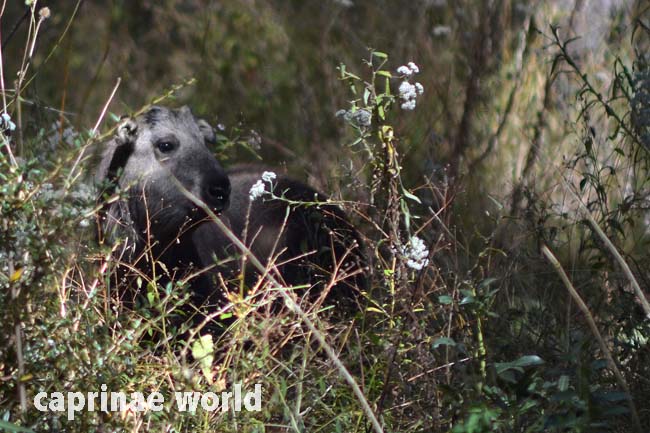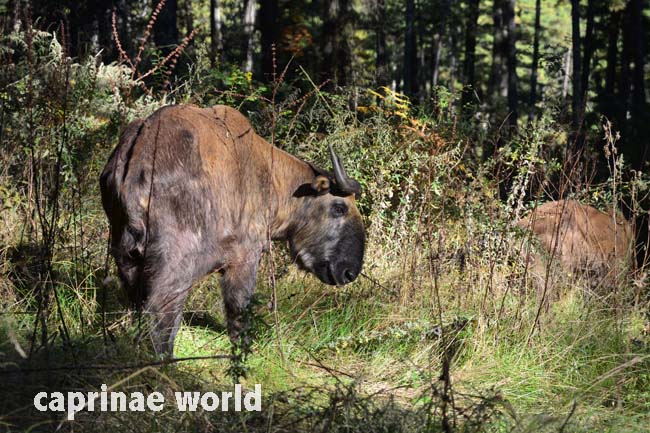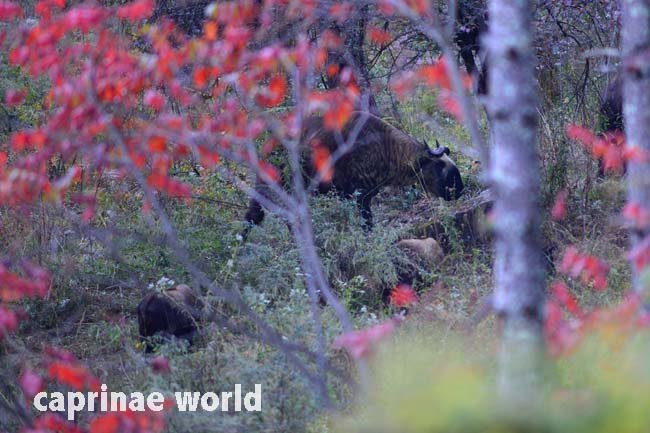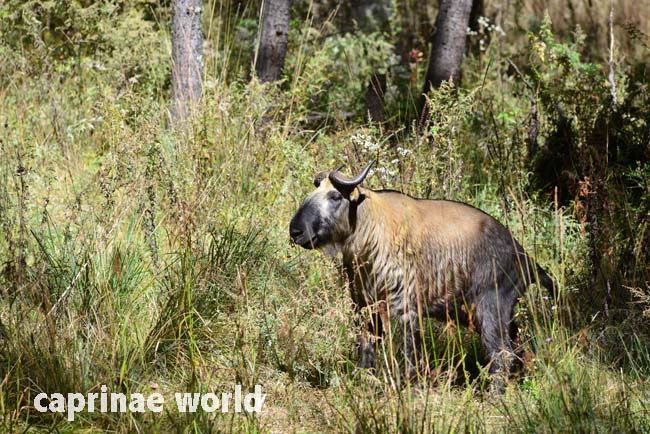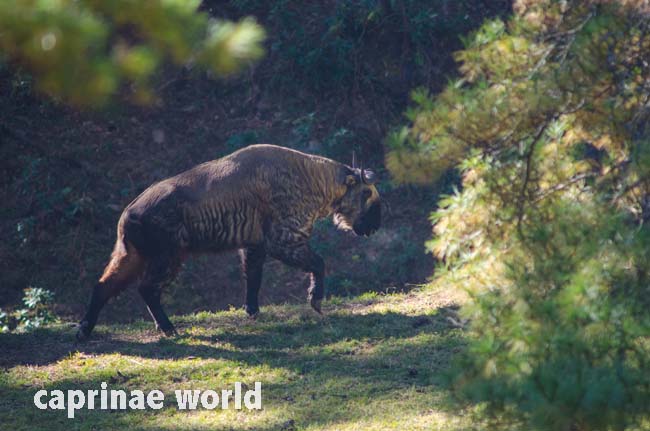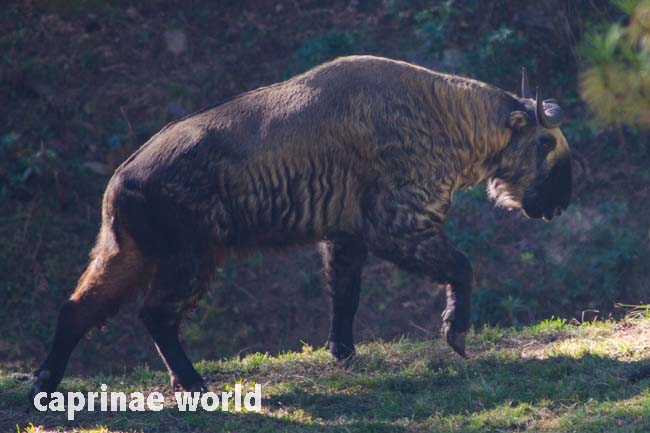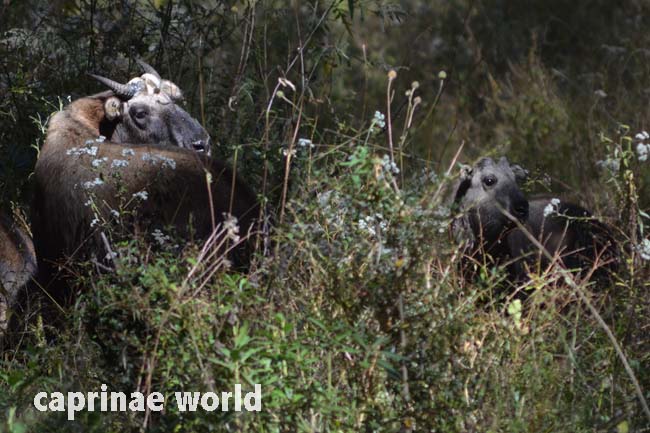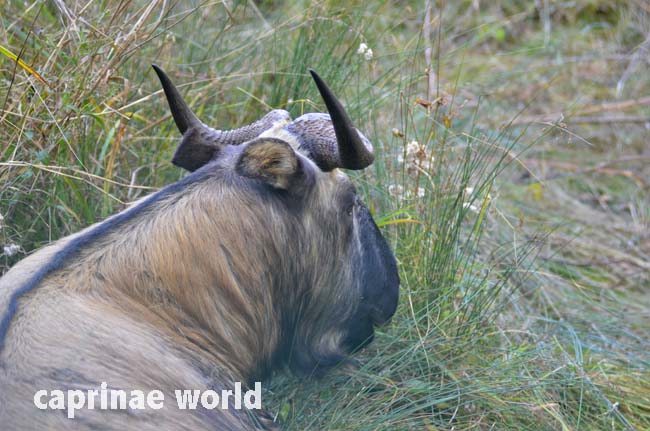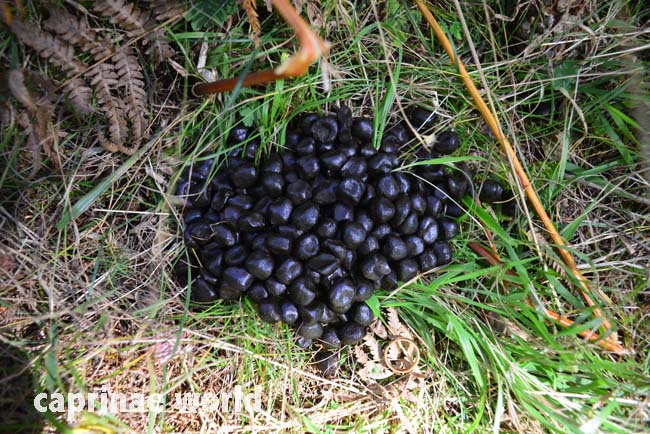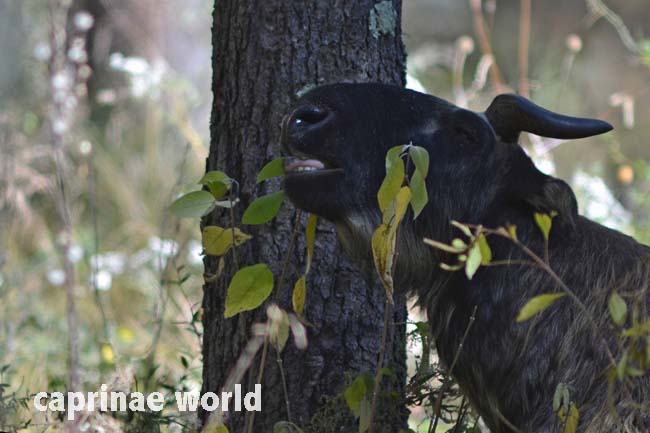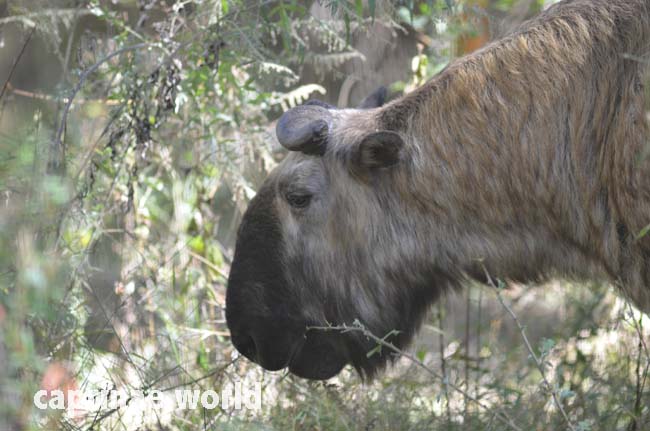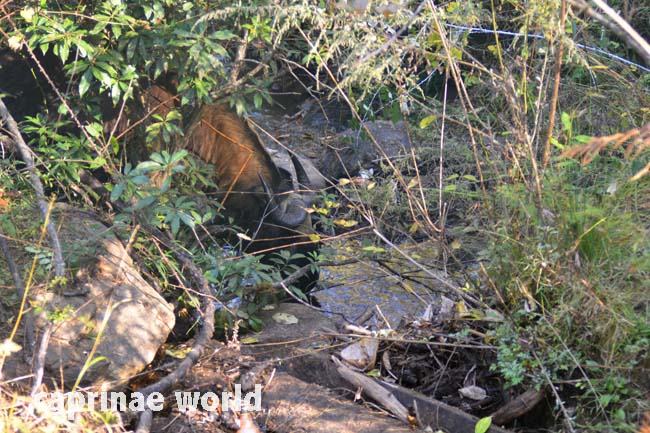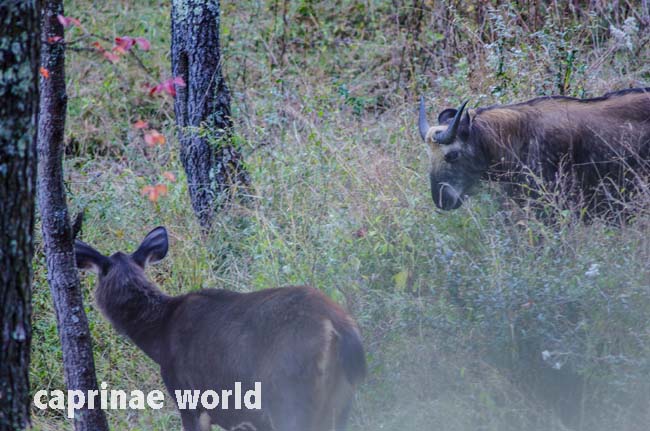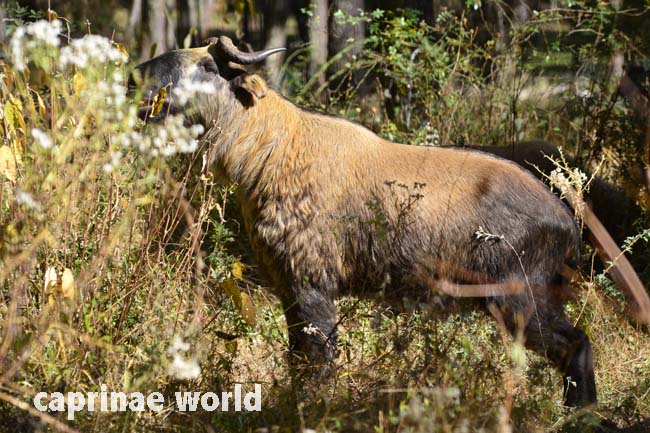The Bhutan Takin is the westernmost occurring Takin subspecies. It is similar to the Mishmi Takin.
Names
Burmese: Tha Min [2]
Chinese: líng niú bù dān [2]
English: Buthan Takin [2]
French: Takin de Bhutan [2]
German: Bhutan Takin [2]
Spanish: Takin de Butan [2]
Tibetan: Ri-ka; Ye-more, Shing-Na [2]
Other (putative) scientific names and synonyms
none known
Taxonomy
Budorcas taxicolor whitei Lydekker, 1907 [7]
Neas and Hoffmann (1987) recognize four subspecies: B. t. bedfordi, B. t. taxicolor, B. t. tibetana, and B. t. whitei. This taxonomy seems to be accepted by both western (Grubb 2005) and Chinese scientists (Wang et al. 1997, Zheng et al. 2003). In addtion some authors see the Bhutan Takin as a full species (Budorcas whitei) [1, 4, 16]. In an analysis of the mtDNA control region, Li et al. (2003) identified three clades that corresponded generally with the three Chinese subspecies sampled [6] – ((editor’s note: all four subspecies occur within China))
Based on a phylogenetic study, Takins are related to Caprines and in particular to Aoudad and Sheep (Ovis). Monotypic [16]
diploid chromosome number: 52 [2]
Similar species / subspecies
The Mishmi Takin (B. t. taxicolor) is very similar in pelage colour. [2, 4]
Distribution
by country / state: Bhutan (North); India (Northeast) / Sikkim, Arunachal Pradesh; China / Xizang [2]
In China, Tibet, this subspecies is known to occur in the Yarlung Zangbo valley [13] (upper Brahmaputra) and south of it, from Gyaca, Nangxian, Mainling, Myingchi, Cona and Lhunze, on the southern flank of the Eastern Himalaya, to the west side of the big bend of the Yarlung Zangbo River. [6, 12]
In Bhutan, no censuses have been carried out, but it is believed that Bhutan Takin occur in scattered populations throughout the forested and unforested mountain slopes along Bhutan’s northern border. One or two populations are known to occur on both sides of the upper catchment of the Mo Chu (Wollenhaupt, 1990). Within Bhutan, Jigme Dorji National Park is the main stronghold, but they are also found in northern Wangdue and Bumthang districts (Tshewang Wangchuk pers. comm., 2008). These populations appear to be separated from those in Tibet.
Within India, Takin is found in Arunachal Pradesh (both along its western border with Bhutan and its northeastern border with China and Myanmar), and in Sikkim. [6, 12] ((editor’s note: this encompass also the Mishmi Takin))
Damm and Franco (2014) believe that the eastern boundary of the distribution range is defined by deep river gorges of the tributaries of the Brahmaputra west of the Mishmi Hills, which maintain some sort of a geological barrier between the Bhutan and Mishmi Takin. [2]
Description
Takins in general have large, bovine-like bodies, a shaggy coat including long hair on the jaws and chin, stout legs, prominent dew claws, and are taller at the shoulder than the hip. [16]
Groves and Grubb (2011) write that Bhutan Takin males are small in size, but their population (N) is only 2. [4] They further state that the teeth of Bhutan Takin are relatively large, but again the population concerning this issue is very small (N = 5). Both Castello (2016) and Damm and Franco, 2014 (citing Lydekker, 1908) consider the Bhutan Takin the smallest subspecies.
The following measurements of Wilson and Mittermeier (2011) probably refer to Takins in general [16]:
body length: 170-220 cm – males are significantly larger than females [16]
shoulder height: 107-140 cm; [16]
weight: 150-350 kg [16]
tail: 10-20 cm [16]
Colouration / pelage
General body colour is dark brown with paler back and a middorsal stripe. [16] It is similar to the Mishmi Takin (B. t. taxicolor). [4] Damm and Franco (2014) write that the pelage is darkish brown, apparently on average some shades darker than the Mishmi Takin, with a small dun saddle (Lydekker 1908; Wu 1985). The sides of the neck and the forehead are also dun coloured. [2] None of the above mentioned authors distinguishes between sex or seasons.
limbs: almost black [2]
underparts: almost black [2]
head: front and sides black [2]
dorsal stripe: black; extending from back to head [2]
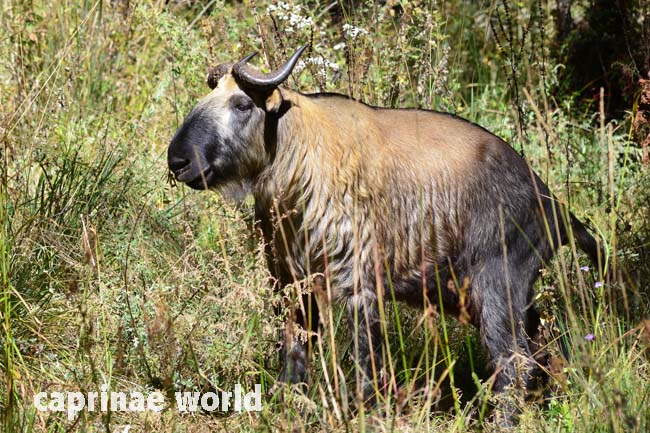
Male in November. Note the light yellowish-brown back and neck. Photo: Ralf Bürglin / Motihtang Preserve, Thimpu, Bhutan, 2016-11-06
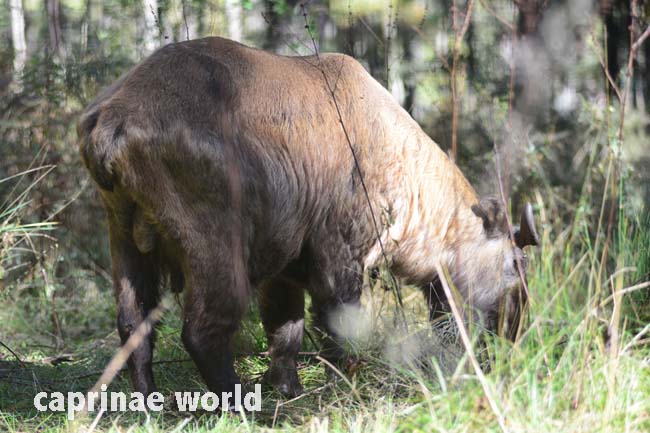
Old male in November. Note the almost uniform body colour. Photo: Ralf Bürglin / Motihtang Preserve, Thimpu, Bhutan, 2016-11-06
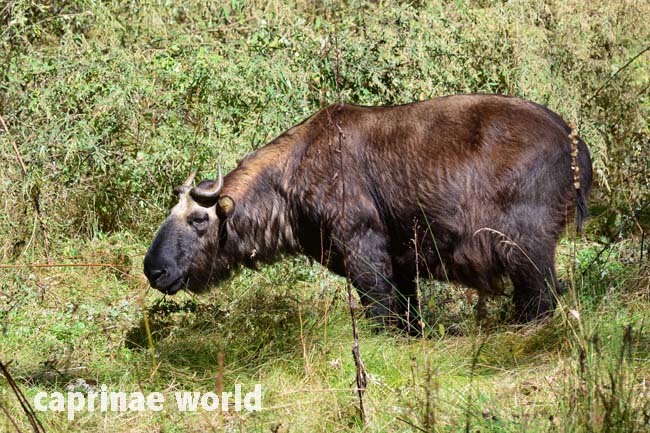
Female in November. Note the dark brown pelage. Photo: Ralf Bürglin / Motihtang Preserve, Thimpu, Bhutan, 2016-11-06

Presumably young male in November. Note light-brown saddle and neck. Photo: Ralf Bürglin / Motihtang Preserve, Thimpu, Bhutan, 2016-11-06
Horns
As in all Takins horns grow slightly upward, and then turn outward and backward with the horn tips upward. Male’s horns are significantly larger than those of females. Horns less widely spread, with tips less turned inward, than in the Sichuan Takin (B. t. tibetana). [16]
Groves and Grubb (2011) write that horns seemingly remain small [4], but their population (N) is very small. Damm and Franco (2014) report that the small horns of Bhutan Takins are anecdotal and add horn measurements of another four specimens (N is again very small). Nevertheless they see smallness of Bhutan Takin horns confirmed. [2]
lengths of four specimens are between 25,4 and 36,8 cm
circumferences are between 20,0 and 23,5 cm
tip-to-tip spreads are between 19,7 and 29,2 cm [2]
They further state that the basal horizontal portion of mature Bhutan Takin male’s horns is considerably shorter, resulting in on average shorter horns compared to those of other Takin subspecies. Bhutan Takin horns are also said to be less massive. The curved upper portions of the horn are of similar dimensions. The skulls of individuals of all Bhutan Takin age classes are smaller in most, if not all dimensions. [2] ((editor’s note: quotation missing))
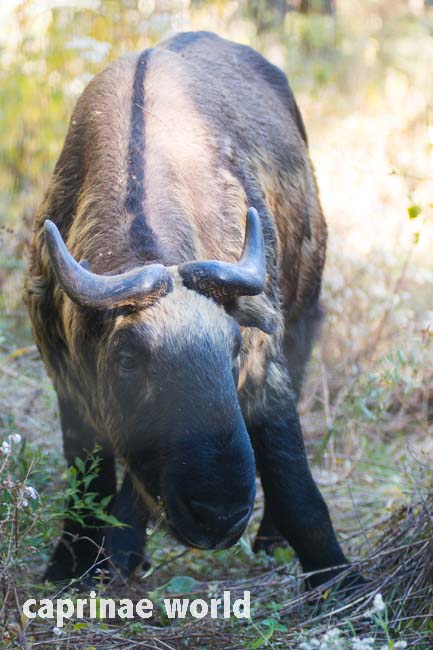
Old male. Horns have been prone to strong abrasion. Photo: Ralf Bürglin / Motihtang Preserve, Thimpu, Bhutan, 2016-11-06
Habitat
Bhutan Takins usually occur at elevations from 1.200 to 3.500 metres [16] and between 2.000 to 4.500 metres respectively, sometimes entering as low as 1.500 metres [2]. They live in a variety of vegetative communities, from above timberline to subalpine and subtropical forests. Habitats, especially at lower elevations, have been modified by humans. [16]
Food and feeding
Takins are opportunistic herbivores, but are primarily browsers, feeding on shrubs and trees. Forbs can be an important food component in spring. They frequent salt licks. [16]
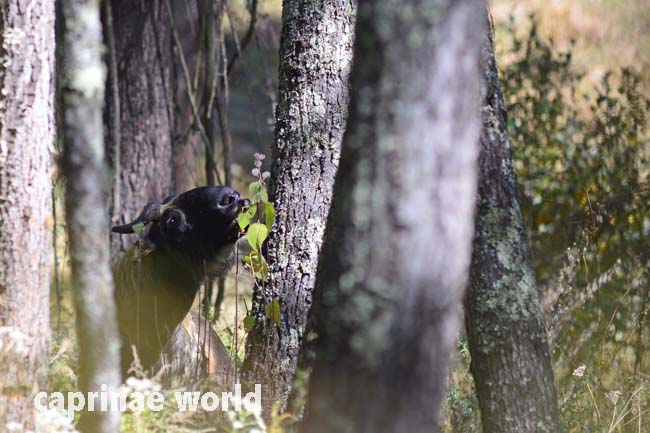
A female Bhutan Takin feeding on leaves. Photo: Ralf Bürglin / Motihtang Preserve, Thimpu, Bhutan, 2016-11-06
Mortality / Predators
no information
Breeding
sexual maturity: ca. at 3,5 years, but males probably do not participate in mating until they are several years older than that. [16]
rutting season: probably in August to September [16]
gestation: 210 days [16]
lambing season: March and April [16]
young per birth: only one in the wild [16]
Activity pattern
Takins in general are usually most active in early morning and late afternoon but in winter they may feed intermittently throughout the day. [16]
Movements, home ranges and social organisation
Takins make seasonal movements to higher elevations in summer and lower elevations in winter. Large mixed herds form in spring and split into smaller herds by autumn. Mature males are solitary or form groups of twos. [16]
Status
IUCN classifies the species as „vulnerable“. Date assessed: 30 June 2008 [6]
There is no known estimate of population size or trend for B. t. whitei within China, Bhutan, or India. [2, 6] Within Tibet about 500 animals may survive (Wu undated, pers. comm. to Groves). [2]
Threats
With almost no management or protection in the remote border areas of China, poaching by local people is hard to control, especially poaching of large herds in winter is reported to be a serious problem (Feng et al., 1986).
In Bhutan, threats include competition and disease transmission from domestic livestock, habitat loss (pasture burning), and loss or disruption of migration routes. In India, major threats come primarily from habitat loss resulting from activities such as timber harvesting, cane and bamboo cutting and road construction, all associated with human populations that continue to encroach on areas occupied by Takin. Local people are also known to poach Takin regularly, both within and outside protected areas. Recent surveys of Takin found evidence of poaching in the Siang Valley and Kamlang Wildlife Sanctuary but only limited sign of the animals themselves, whereas in Mehao Wildlife Sanctuary, considerable numbers of Takin tracks and droppings, and evidence of poaching were found (Katti et al., 1990). Current levels of poaching by local residents may not represent a significant influence on takin populations (Katti et al., 1990). [6]
Many populations have a disjunct distribution and are vulnerable to extirpation due to poaching and habitat loss. Domestic Yaks may compete for summer forage at higher elevations. Unmanaged timber extraction may cause loss of winter habitat. [16]
Conservation
Bhutan: This taxon is currently listed in Schedule I of Bhutan’s Forest and Nature Conservation Act (1995). The species is known to inhabit Jigme Dorji National Park. [6] Ugyen Wangchuck Institute for Conservation and Environment (Bhutan) cooperates with the Max Planck Institute in Germany, the University of Montana (UM), the Wildlife Conservation Society (WCS), the Smithsonian Institution and the Bhutan Foundation in a new project to understand population dynamics, migrations and conservation needs of Bhutan’s national animal. [2]
China: It is found in Nujiang (Yunnan) and Muotua (Feng et al., 1986) Nature Reserves. [6]
India: The Takin is classified under Schedule I of the Wildlife Protection Act of India. [16]
Conservation measures proposed include:
1) educate local people to make them aware of conservation legislation; 2) develop co-operative conservation measures between countries;
3) undertake a survey to census numbers and delineate distributions;
4) special emphasis should be given to determining and preserving its migration routes between seasonal ranges to protect Takin habitat (Wollenhaupt, 1990);
5) in India, establish the proposed biosphere reserve that encompasses the Namdapha National Park and several additional protected areas in northeastern Arunachal Pradesh (if adequately protected, these areas would significantly increase the number and size of effective conservation areas for Takin) – ((editor’s note: this measure refers mainly to the Mishmi Takin))
6) continually reassess human populations and their increased access in the Takin distribution area since the species is commonly hunted by locals. [6]
Recreational Hunting
not a factor
Ecotourism
Most travellers see Bhutan Takins at Motithang Takin Preserve near Thimphu, the capital of Bhutan, where the animals are a major tourist attraction. But this „preserve“ is basically a zoo and it is the only institution that keeps captive Bhutan Takins. Wild animals can be seen on guided trekking tours through Jigme Dorji National Park.
Literature cited
[1] Castelló, José R., 2016: Bovids of the World – Antelopes, Gazelles, Cattle, Goats, Sheep, and Relatives. Princeton University Press
[2] Damm, Gerhard R. and Franco, Nicolás, 2014: The CIC Caprinae Atlas of the World – CIC International Council for Game and Wildlife Conservation, Budakeszi, Hungary in cooperation with Rowland Ward Publications RSA (Pty) Ltd., Johannesburg, South Africa
[4] Groves, Colin and Grubb, Peter, 2011: Ungulate Taxonomy. The John Hopkins University Press
[6] Song, Y.-L., Smith, A.T. & MacKinnon, J. 2008. Budorcas taxicolor. The IUCN Red List of Threatened Species 2008: e.T3160A9643719. http://dx.doi.org/10.2305/IUCN.UK.2008.RLTS.T3160A9643719.en. Downloaded on 25 February 2019.
[7] Matschei, Christian, 2012: Böcke, Takine & Moschusochsen. Filander Verlag
[12] Shackleton, D. M (ed.) and the IUCN/SSC Caprinae Specialist Group, 1997: Wild Sheep and Goats and their Relatives. Status Survey and Conservation Action Plan for Caprinae. IUCN, Gland, Switzerland and Cambridge, UK. 390 + vii pp
[13] Smith, Andrew T. and Xie, Yan, 2008: A guide to the mammals of China. Princeton University Press
[16] Wilson, D. E. and Mittermeier, R. A. [eds], 2011: Handbook of the mammals of the world. Vol. 2. Hoofed mammals. Lynx Edicions, Barcelona.



